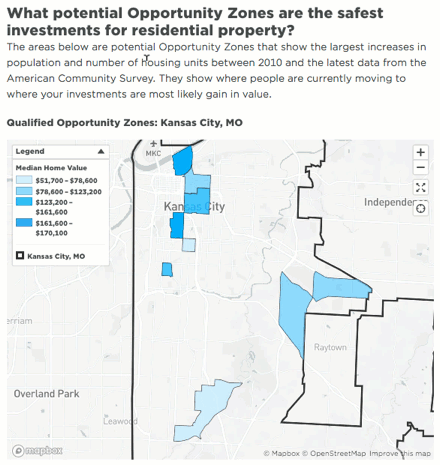
This guest post about Opportunity Zones is by ELGL member Brandon Gumm with mySidewalk.
Unsure? You’re not alone.
The new Tax Cuts and Jobs Act, signed into law by President Donald Trump last December, introduced a brand new designation for low income communities called “Opportunity Zones”. Today, states around the country are scrambling to build lists of qualifying census tracts so that they can benefit from these new designations and qualify for new tax incentives on capital gains. The hope is that these zones will see years of new investment in areas that have historically seen decades of disinvestment.
The twist? Only 25% of all qualifying census tracts can be chosen. Also, the deadline is March 21.
To qualify, census tracts must have at least a 20% poverty rate or 80% of households must make less than the metropolitan or statewide median family income. As an example, at the bottom of this report, you can find a map highlighting all of the qualified census tracts in the state of Missouri.
With such a big decision arriving so soon, states are turning to local economic development organizations in cities and counties to help decide which census tracts should make the cut. We’ve heard from several of these organizations looking for data to help drive their decision. mySidewalk is working with them to identify qualifying census tracts and target areas that are safer investments or in the most need. Our data-driven approach has helped local governments advocate to their State for census tracts that align with local need.
Below are some of the successful strategies we’ve seen from our partners and how mySidewalk is working with them to select their new Opportunity Zones.
Capitalize on your momentum and choose census tracts that have seen recent population increases.
Sources: US Census, ACS 2012-2016
One way we’re seeing our partners utilize Opportunity Zones is by speeding up or helping finance investments that have already been planned. These are typically in areas that have seen recent population increases where demand for new homes outstrips supply. Why not give these areas a boost and increase the capital returns on these developments? Smart organizations are planning for this and leveraging this opportunity to negotiate for higher quality real estate developments.
How can mySidewalk help? By mapping out areas that have seen the largest population and housing unit increases between 2010 and today, we are able to locate census tracts that are booming and find tracts that could benefit even more from the new Opportunity Zone designation.
Create new job gains by choosing census tracts with growing job density.
Sources: US Census. Center for Economic Studies. LEHD Origin-Destination Employment Statistics (LODES) Workplace Area Characteristic Files. Version 7.3. 2002-2015.
For those that want to use this new designation to boost job gains, organizations are turning to data that shows census tracts with growing job density. These growth areas present an opportunity for business owners to invest in their real estate and expand their operations without the burden of capital gains taxes.
How can mySidewalk help? Our web-based application identifies census tracts that have seen the largest job gains between 2002 – 2015 using the most recent datasets from LODES. We can also examine wage data and identify which industries are most prevalent.
Choose the census tracts that are in the most need of investment.
Sources: ACS 2012-2016
Probably the most common concern we hear from our partners is that Opportunity Zones will only lead to increased gentrification or abuse from outside investors that do not have the existing community in mind. One solution we’ve seen from cities and Land Banks is choosing census tracts that have the most publicly owned land. The goal here is to control the investment and ensure it gets into the right hands. These areas align well with those that are in the most need of investment. They tend to have the lowest home value, median household income, and low home ownership rates.
How can mySidewalk help? Using our filtered maps, we can identify the census tracts that are in the most need of outside investment. Public organizations can use this to align their strategies to control future development in the most vulnerable areas.

Want help selecting Opportunity Zones in your community?
mySidewalk will work with your organization to identify qualifying census tracts before the March 21 deadline. Fill out the form below to connect with a team member today or email hello@mySidewalk.com with questions. Want help selecting Opportunity Zones in your community? mySidewalk will work with your organization to identify qualifying census tracts before the March 21 deadline. Email hello@mySidewalk.com with questions.
mySidewalk is a city intelligence tool that helps analysts track, analyze, and communicate progress on department and citywide goals. Our mission is to empower city leaders and the public with the most complete, clear, and real-time understanding of community data so they can improve and innovate together. You work hard for your data. What’s it doing for you?
 About Brandon:
About Brandon:
Brandon Gumm recently joined the mySidewalk team from the Port of Greater Cincinnati Redevelopment Authority where he worked as a commercial development associate. He spent his time assisting with the development and execution of commercial real estate plans for Hamilton County communities and managing the development of IT systems to track and report on Port and Landbank properties and programs.
He was also responsible for leading all data analysis efforts. Today, he works alongside all mySidewalk customers to make sure the work they are implementing is helping them make progress on their goals and producing measurable outcomes. Brandon graduated with a Master’s Degree in Urban Sustainability and Resilience from Xavier University 2016. However, he has been working to strengthen communities since 2013 leaving him with 4 years of extremely relevant industry experience.


